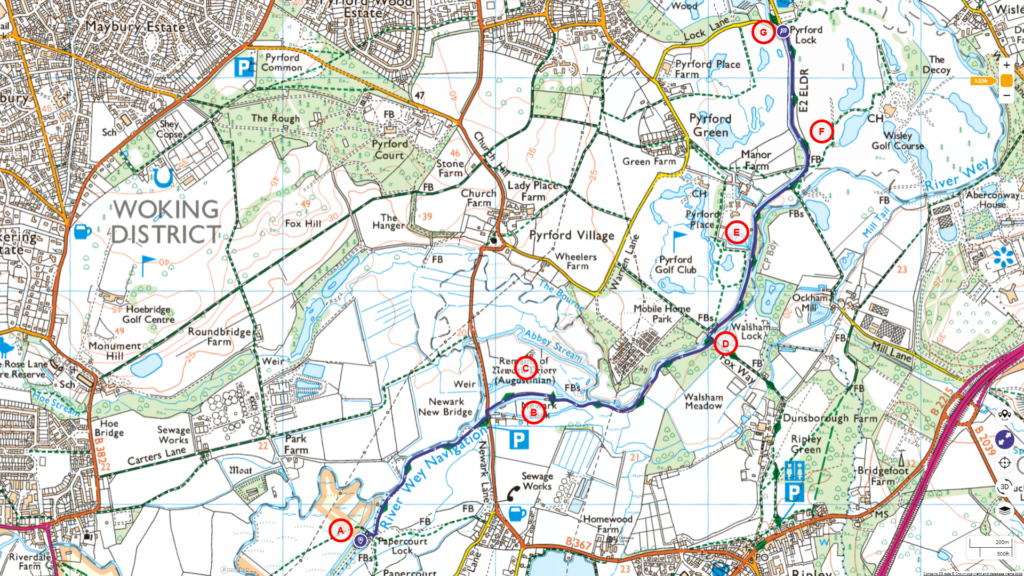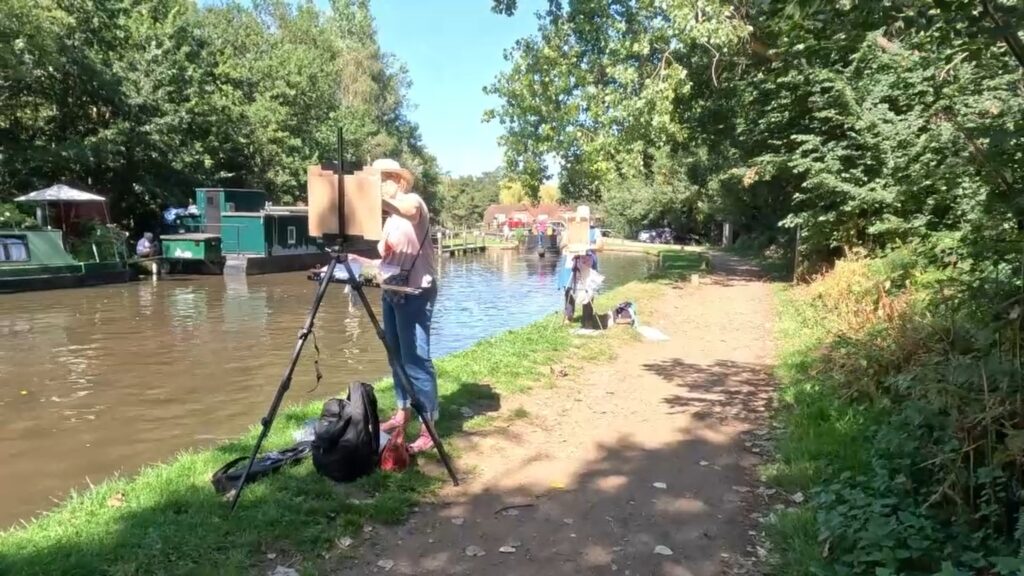The walk take us to the Illyric Newark Lock, showcase the effort for habitat preservation, and the former residence of John Donne.
Follow the entire walk on . The route map is available on
.

B: Newark Lock
C: Newark Priory
D: Walsham Gate
E: John Donne’s Elizabethan Summerhouse
F: Wiseley Golf Course
G: Pyford Lock
Cross the river at Papercourt via a robust bridge, then veer left on the opposite side, passing through a small gate. The path runs alongside the wide river in an open floodplain. On a beautiful day like today, you’ll often spot people taking advantage of the splendid sunshine, reclining with books in hand—a truly idyllic scene.
After approximately 700 meters, you’ll reach the end of the floodplain. Just as you exit the wooden gate, you’ll notice a split in the river, which flows into the Abbey Stream to the north. This channel will soon divide into two separate flows before merging again about 500 meters downstream. Right outside the gate, there’s a wooden footbridge leading up to Newark Lane. The Newark Lane car park is a mere 30 meters to the right.
Take a left over the bridge on the near side. Once you’re on the north bank after crossing Newark Lane, continue to the towpath on the opposite side. Here, you’ll encounter another branch of the river, flowing south around Newark Lock.
Adjacent to Newark Lock, boasting a 1.60-meter rise, you’ll discover the ruins of Newark Priory, which lends its name to both the lock and the surrounding area. Originally built in 1653 using timber, like many others along the Navigation, the lock has since been reconstructed in concrete. It spans one of the shortest man-made sections of the Navigation.
Newark Priory showcases the historical place-name changes in the Valley. Initially known as Aldebury in 1204, it was renamed Novo loco de Andebir, signifying ‘new place of Aldebury,’ in 1210. Ruald de Calva initiated this renaming during a period of significant local ecclesiastical development. The Old English term “burh” referred to a monastic enclosure, and scholars believe the evolution of the name Newark indicated the ‘new building’ for the 7th-century Woking minster established nearby. The priory was strategically situated near what is now known as Abbey Stream, originally part of the meandering River Wey before the construction of cuts that isolated the priory on an island. The region features a network of drainage channels dug by the monks. Regrettably, the ruins are located on private land without public access. Founded in the early 12th century by Augustinian Canons, or ‘Black Canons,’ Newark Priory received significant support from Ruald de Calva and Beatrice de Sanders. Their generosity led to the priory’s prosperity, generating rental income from properties across various parishes, including London, Winchester, and Rochester. The priory complex featured a prominent church.
Nevertheless, the priory fell into disrepair following Henry VIII’s orders during the Dissolution, and over the centuries, it was systematically stripped of its building materials. Today, only a portion of the grand church remains, thanks to Lord Onslow’s intervention, which prevented further plundering.
Among barge crews, legends abound regarding tunnels supposedly dug in the 13th century, connecting the Priory to various destinations. One credible story mentions a tunnel to a nearby nunnery, while a more incredible tale speaks of a tunnel to Guildford, passing under the river five times.
Newark Lock is arguably one of the most picturesque along the River Wey Navigation. This charming location is accessible solely by the canal and its towpath. Shielded by towering oak trees, with the Priory ruins just a short distance away, you’d have little inkling that several sprawling dormitory towns serving the London metropolis are only a few miles away. It’s an ideal spot for a leisurely picnic lunch while observing long canal boats navigating the lock. Here, the river offers an opportunity for a refreshing swim in the open water meadows. You might even spot parents with children on paddle boards gliding gracefully along the calm flowing stream. The nearest pub to Newark Lock is the Seven Stars in Newark Lane, a brief walk from the canal.
After passing Newark Lock, your path crosses to the other side via a metal horse bridge. Beyond a small metal gate and an area of tufty grass, another small metal gate leads to a narrower section. In this area, cattle graze for approximately 400 meters. Exiting this section takes you into the more shaded area of Walsham Meadows on your right. Here, you may catch sight of swans and mallards, gracefully swimming along this part of the river.
Soon, you’ll reach Walsham Gate. This marks the last of the original turf-sided locks opened in 1653, which were common along the entire length of the Wey Navigation. It functions as a flood lock, only closing the gates to divert excess water over the weir when water levels rise too high. As a result, the gates are typically left open. The lock retains its square structure, wide enough to accommodate the large barges that predates the introduction of narrowboats. Walsham Gates is 5.9 miles (9.5 km) from the Thames.
In 2020, work commenced on constructing a new fish pass at Walsham Weir. One of the project’s objectives is to enhance fish and eel passage along 27km of the River Wey by 2021, with plans to open up 100km of passage to the River Thames. The new fish and eel passes will create a migration chain, benefiting fish populations, including coarse fish species, eel, salmon, and sea trout in the River Wey.
You’ll cross the substantial weir with its thunderous cascade of water flowing downstream. The lock keeper’s cottage, rebuilt in 1896 (the original structure was present in 1653), stands on your right. Opposite the keeper’s cottage lies Pyrford Golf Course. Stick to the towpath on the side of the cottage.
To the right of the towpath, behind the keeper’s cottage, you’ll notice a stream. This marks the original meandering River Wey. From here, it winds around Wiseley Golf Course toward Wisley Garden and onward to Weybridge, following a different route. The towpath you’re on is referred to as the Wey Navigation from this point onward, not River Wey.
After about a kilometer, you’ll approach the fairway and greens of Wiseley Golf Course. Further east lies Wisley Garden, the Royal Horticultural Society’s flagship garden and a globally renowned horticultural masterpiece. People visit Wisley for numerous reasons—to marvel at and learn from the extraordinary plant collections, seek inspiration and ideas for their own gardens, participate in workshops and events, enjoy quality time with loved ones, and, above all, relax amid the stunning natural surroundings.
About 400 meters from Walsham Gate, you’ll spot John Donne’s Elizabethan Summerhouse on the opposite bank.
You’ve arrived at Pyrford Lock, roughly 1.5 kilometers from Walsham Gates. This lock, established in 1653 with a 1.45-meter rise, is situated 8 kilometers from the Thames.
Our journey concludes here for the moment. We look forward to having you join us again in our next installment, which will take us from Pyrford to Newhaw Lock.

